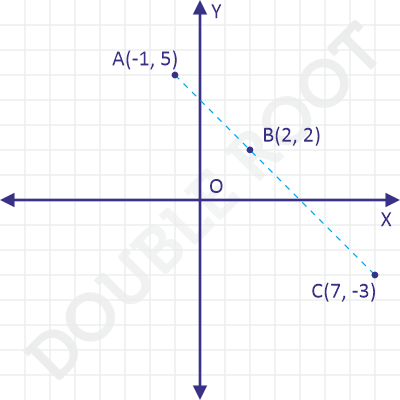Summary
This math recipe will help you determine if three points, whose coordinates are known, are collinear.

Skill Level
Easy
Time
Approx. 1 min
Ingredients
Coordinates of the three points: \(A(x_1, y_1)\), \(B(x_2, y_2)\), and \(C(x_3, y_3)\)
Method
To check if \(A\), \(B\), and \(C\) are collinear, we’ll evaluate the following expression
\(x_1(y_2 – y_3) + x_2(y_3 – y_1) + x_3(y_1 – y_2)\)
If the above expression equals zero, then the points are collinear. Otherwise, they’re not.
Examples
Example 1 Determine whether the points \(P(4, 6)\), \(Q(-2,2)\), and \(R(1, 1)\) are collinear or not.
Solution To check if \(P\), \(Q\), and \(R\) are collinear, we’ll evaluate the above expression:
\(4(2 – 1) –2(1 – 6) + 1(6 – 2)\)
\(= 4(1) – 2(–5) + 1(4)\)
\(= 4 + 10 + 4\)
\(= 18\)
Since the expression is not zero, the points \(P\), \(Q\), and \(R\) are not collinear. The figure shows the three points on the \(XY\) plane.

Example 2 Determine whether the points \(A(-1, 5)\), \(B(2, 2)\), and \(C(7, -3)\) are collinear or not.
Solution To check if \(A\), \(B\), and \(C\) are collinear, we’ll evaluate the above expression:
\(–1(2 –(–3)) + 2(–3 – 5) + 7(5 – 2)\)
\(= –1(5) + 2(–8) + 7(3)\)
\(= –5 – 16 + 21\)
\(= 0\)
Since the expression is zero, the points \(A\), \(B\), and \(C\) are collinear. The figure shows the three points on the \(XY\) plane.

That’s it for this recipe. Hope you found it helpful.
For more recipes, please visit www.doubleroot.in/recipes.
You can follow me on Instagram, Twitter, or Facebook to get all updates.